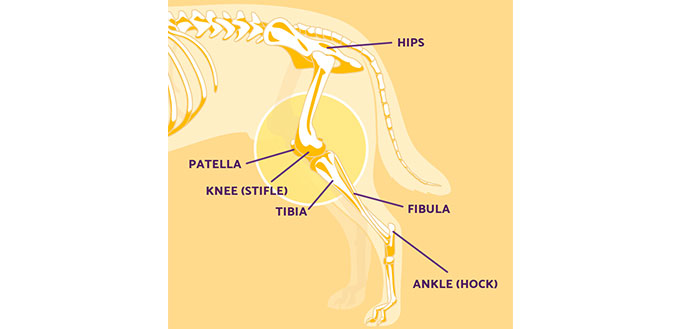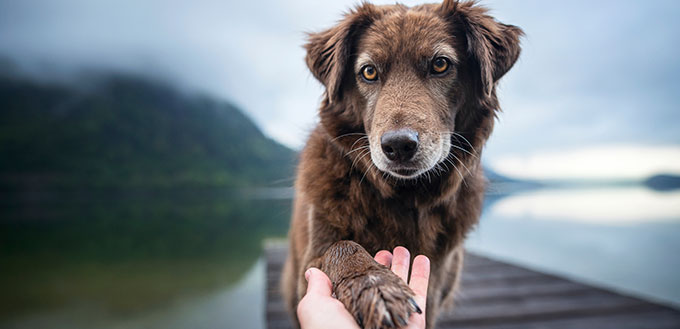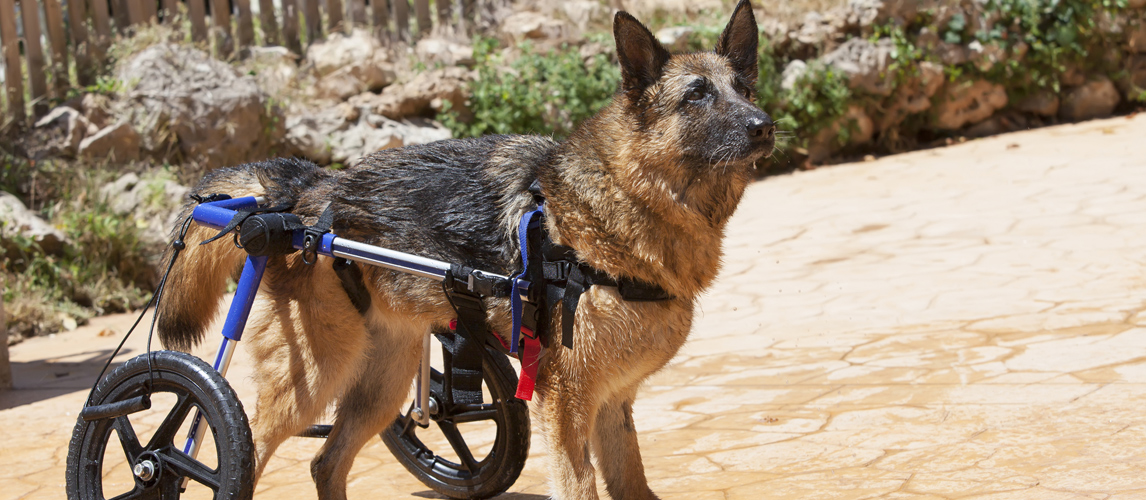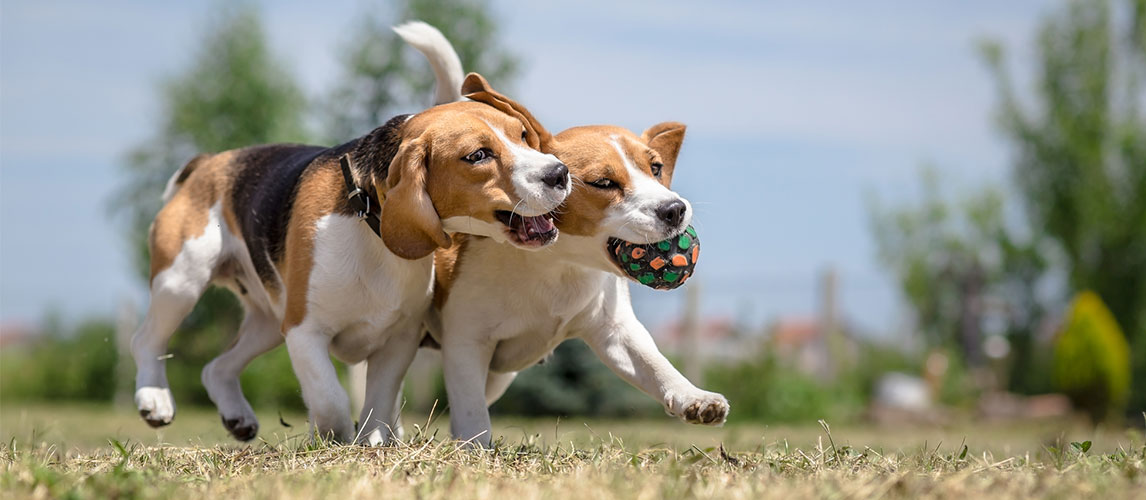Knee problems in dogs are unfortunately common. So much so that most owners can expect their dog to have some kind of trouble with their knees at some point in their life. Much like with humans, as we get older our joints stiffen up. With the hip and knee joints being the worst culprits. Knee pain in dogs can sometimes be difficult to pinpoint, however, as dogs are quite good at hiding their discomfort. Additionally, knee problems are often misconstrued as hip problems or a pulled muscle. Understanding the possible knee conditions your dog could experience during its life can help you to recognize the symptoms and be aware of how best to help them.
Where Is a Dog’s Kneecap?
Believe it or not, dogs don’t have 4 knees, but rather two knees and two elbows, just like humans. And the knees are located on the hind legs, whereas their elbows at on the front legs. The knee joint connects the patella (thigh bone) to the tibia and fibula (lower leg bones). The knee cap itself is also known as the stifle. A dog’s knees take more stress with daily activities, as they provide the force required for propelling the body forward and jumping. They also act as shock absorbers and are more likely to be damaged as a result.
Image credit: Orthodog
What Are the Most Common Knee Problems?
There are three knee conditions that are the most common and can affect anything from small breed dogs to larger breed dogs. We have included a list of symptoms with each one as well as ways in which you can help your pup deal with the discomfort.
Cranial Cruciate Ligament Rupture
The cranial and caudal cruciate ligaments form the connection between the distal femur (lower) and the proximal tibia (upper). These ligaments are there to provide stability and control for the knee joint. Humans actually have these same ligaments, however, they’re known as the posterior cruciate ligament (PCL) AND anterior cruciate ligament (ACL).
This particular knee injury occurs more often than you would think. It is the most common of canine knee injuries owing to the fact that there is no single cause for cranial rupture. Dog CCL injuries are most often the result of a genetic predisposition to degeneration in the ligament as the underlying cause, however, it can also be caused by acute injury.
What happens?
It most commonly happens during an active period as the result of a dog suddenly changing direction whilst at speed or whilst jumping around. This can cause the dog’s knee to twist in an abnormal way. The excessive strain placed on the cruciate ligaments can cause the front (or cranial) ligament to rupture. Many dogs sustain this injury during their walks when they have space to run freely.
When this happens it will cause irreparable damage to the ligament. It can be treated and repaired to a degree, however, there will be lasting effects from the injury, and weight loss may become difficult with the new restriction on mobility.
Signs and Symptoms:
- Crackling noise from the affected leg due to bones rubbing together
- Swelling
- Joint instability and decreased range of motion
- Lameness/reluctance to move
- Pain when touched or moving
- Limping
- Irritability as a result of discomfort
- Firm or thick feel of the joint
Treatment:
- Get your dog to a vet immediately for a diagnosis
- An x-ray will be necessary to attempt to assess the damage
- Surgery to repair the ligament may be required
- Anti-inflammatories, antibiotics, and painkillers
- Rest and physiotherapy
- Weight control during the recovery period
Patellar Luxation
A luxating patella is the most common of canine knee injuries in breeds of any size, though patellar luxation typically occurs in puppies between four and six months of age, but can also start to show in senior dogs. It can be the cause of cartilage damage, inflammation, pain, and ligament tears. Owners should familiarise themselves with the symptoms in order to know how to help their dogs to protect their knees by looking out for the signs. In at least 50% of cases, the patella dislocation occurs in both knees. It is generally not caused by injury, but rather a genetic predisposition to patellar luxation in general, a predisposition that is more common in small breed dogs.
What happens?
A luxating patella (aka, floating kneecap) in dogs is effectively a dislocation. Severe luxation is when the kneecap pops out of the joint either laterally (outside) or medially (inside) on a regular basis. Whereas mild luxation is less common and the after-effects are less severe. Around 50% of the time, patellar luxation occurs in both knees. Once a dog begins to experience patellar luxation, it will continue to have it for the remainder of its life, meaning you will need to know how best to manage it.
Signs and Symptoms:
- Intermittent lameness
- Decreased mobility and stiffness
- Buckling of the knees
- Pain or discomfort when moving
- Popping or cracking in the knee
- swelling and stiffness of the knee
- A large lump where the kneecap has slipped from the joint
- Irritability
Treatment:
- A rehabilitation period may be necessary
- Purchase knee braces for added support
- Surgery for more extreme cases
- Prescribed painkillers and anti-inflammatories
- Sensible exercise
Arthritis
There’s a variety of causes of arthritis in dogs, including infections and trauma to the joint surfaces. Genetic predisposition and aging can also cause arthritis in dogs of all ages, however, you mainly find it to be most prevalent in seniors and obese dogs. It is not strictly a knee problem because it affects all of the dog’s joints including the hips and shoulders. Arthritis is the most difficult to treat as it’s a chronic problem that can’t simply be fixed by surgery or physiotherapy. Dog owners simply have to help their dog to manage it.
What happens?
Arthritis causes swelling and tenderness in the joints. It is something that tends to slowly develop over time, though the initial onset can be triggered by injury. It is caused by the continued use and wearing of the joints. If a dog experiences an injury in their life that changes the way that they walk, they may apply additional pressure on certain joints, meaning there is a possibility that it could develop faster in the joints taking most of the stress.
Signs and Symptoms:
- Stiffness in legs
- Discomfort or pain
- Irritability
- Difficulty with mobility
- Swelling joints
- Tenderness in joints
- Loss of appetite
- Disinterest in activities
Treatment:
- Physiotherapy sessions
- Analgesics and painkillers
- anti-inflammatory medication
- Joint repair surgery in extreme cases
- Purchase knee braces to relieve strain and discomfort
How Can I Help My Dog With Knee Problems?
There are several ways that you could at least try to prevent the worsening of knee problems. Unfortunately, they are often a chronic problem with no easy fix, however, finding ways to keep them comfortable and make things easier for them is an ever-present need.
Install a Ramp or Steps
Installing a dog ramp and shallow steps will minimize the impact on the patella, lessening the chances of patellar luxation. This can also help to keep arthritic dogs more comfortable with daily activities.
You may also like our article on the Best Dog Stairs for Bed.
Watch Their Weight
Weight control is also very important when it comes to joint complication prevention. An overweight dog is far more likely to develop knee problems owing to the added straight in their joints, whereas a lean dog will have a much easier time with general movement. So be careful to monitor their food intake, feed them food for weight loss if needed, and maintain a healthy diet and exercise regime.
Purchase an Orthopedic
Providing your pooch with an orthopedic dog bed from the get-go can also help, especially in cold winter months which can affect the health of your dog’s joints as they are more likely to stiffen up in cold conditions.
Purchase Knee Braces
Knee braces serve the same function with dogs as they do with humans. By that, we mean that they provide strong support for knees that are struggling with the strain of daily life. A knee brace can at least lessen the strain on the joint and relieve some of the discomfort.
How Do You Know if Your Dog Has a Knee Injury?
Affected dogs tend to have more difficulty navigating the world when compared to their healthy-kneed counterparts. You can ordinarily recognize a knee injury in a dog much like you can in a human – they will limp. However, some dogs can be quite stubborn in hiding their discomfort, which is perfectly natural considering they would need to hide their weakness in the wild, and so there are a few other signs you can look out for.
- Difficulty climbing in and out of bed
- Whimpering or yelping when standing after a long period of rest
- A lack of enthusiasm in activities they would otherwise love
- Refusal or reluctance to move quickly
- Swelling in the joints
- Irritability or negative reactions when touched around the joints
- Loss of appetite
- Buckling legs when moving regularly
When Should I Take My Dog To The Vet?
If your dog is showing visible signs of discomfort, it is always worth taking them to the vet to be assessed. That assessment can help you to put together a treatment plan or prepare adjustments you may need to make to accommodate them. If you notice a dramatic change in their behavior, or if they are incapable of standing or walking, take them to the vet immediately. Your vet can then look for any underlying problems that could be causing major complications.
FAQs:
Q: Are dog knee braces effective?
A: Dog knee braces have their pros and cons. There are a bunch of different styles on the market, but you should be sure to pick the correct fit for your pooch. Given that you have selected the correct type of brace, they can be highly effective in relieving pain and discomfort for dogs with knee conditions. They are not an instant fix by any means, but can certainly help.
Q: Where are a dog’s knees located?
A: Knee joints are located between the thigh bone (femur) and the lower leg bones (tibia and fibula) The dog knee joint is also called the “stifle’ joint. There are strong ligaments in the knee at the top, bottom, and along the sides. Dog’s knees are only on their rear legs and the front legs have elbows.
Q: Can a dog’s knee pop out of place?
A: Yes, this is known as patellar luxation. It is unpleasant for the dog and can be quite painful. If your pup does not seem to be getting better after a dislocation, take them to the veterinarian who may need to treat the dislocation professionally.
Q: Does dog insurance cover knee surgery?
A: Absolutely. Most pet insurance companies will have policies that cover knee problems and knee surgery. However, be sure to check the details of your policy carefully before committing in order to ensure you are getting the cover you will need. Especially if you have a breed of dog that is prone to knee or other joint conditions.
Note: The advice provided in this post is intended for informational purposes and does not constitute medical advice regarding pets. For an accurate diagnosis of your pet's condition, please make an appointment with your vet.










